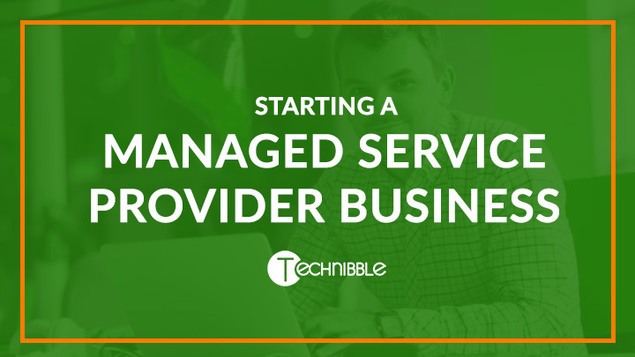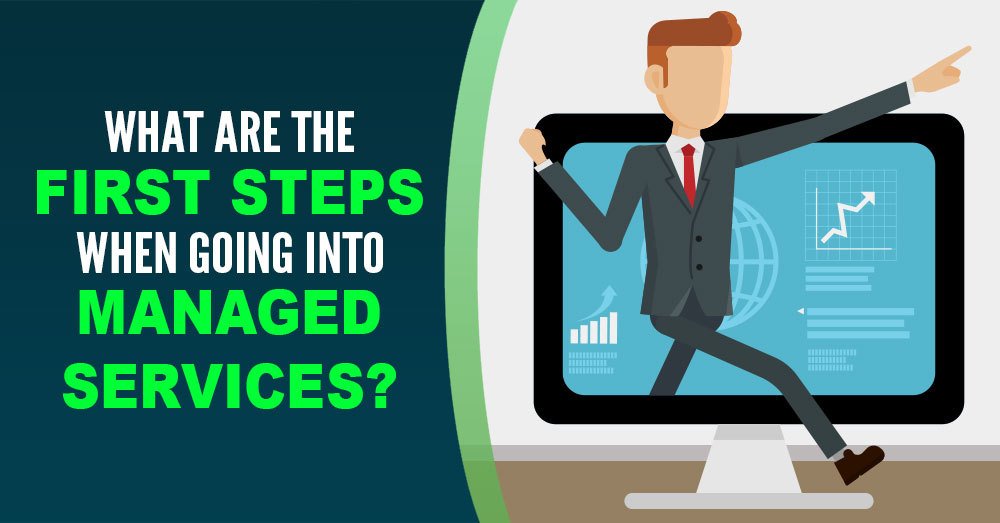- You are here:
- Home »
- Blog »
- Manage Your Computer Business »
- Starting a Managed Service Provider Business

Starting a Managed Service Provider Business
With the exponential growth of technology, most businesses today find it more profitable to go digital. This has created a greater need for stable IT infrastructure and support. Thus, increasing the demand for professional and reliable managed service providers (MSP).
According to Fortune Business Insights, the global managed services market was worth USD 200.29 billion back in 2019. And it is projected to rise further, hitting USD 492.15 billion by 2027!
Below is a bar chart demonstrating the projected rise of the managed services market in North America alone.
With this current rising trend, techs looking to start a computer business are leaning strongly towards becoming managed service providers. While ready-established businesses under the break-fix model are looking into making the transition to managed services.
Are you one of those considering entering the MSP playing field? This article can help you “test the waters”, and provide guidance to help you get your managed services business up and running.
What are the First Steps When Starting a Managed Service Provider Business?

One of our Technibble forum members asked the question: “What are the first steps when going into managed services”?
The short answer: Put together a managed services package that people want and then learn to sell it.
So what exactly do people want?
Well, that’s the hard part.
Focus on finding out what problems your prospects have and build a package around that. Most of the time when MSPs are failing to convert, they are pitching products and services that the client simply doesn’t care about.
What are the problems for the businesses around you?
Legal, medical, and finance businesses need to meet certain regulatory requirements.
Can you help them with this?
Maybe you are stuck in rural America with nothing around you but a bunch of farms. What technology are farmers using? It’s not uncommon to see farms with cameras in their barns with point-to-point wireless going to the house.
Can you help the farms get connected?
The First Steps When Going Into Managed Services
1. Don’t Get Seduced by the Tech
As techies, it’s easy for us to focus on the technical side when starting a managed service provider business. What RMM should we choose? How do we automate it? What is the ideal tech stack?
While these decisions will help you once you have clients, you need to first get the clients.
Your clients don’t care about which RMM you use, or how you are going to automate it. All they care about is how you are going to help them.
By getting clients first, it’s easier to choose your RMM based on what features you’ll need to support them. You will also have the funds to choose the best option rather than what fits your ‘before clients’ budget.
2. Specialize Your Packages
Gone are the days where you can just install some RMM software, virus protection, and a backup solution and call it a day.
While these are essentials, there is no differentiator between you and another MSP. As soon as another MSP pitches to your client with a lower price, they are likely to change providers.
You also don’t want to counter your competitor with an even lower price, as that becomes a race to the bottom. Instead, do something better than everyone else, or even do something that no one else does at all. That way it’s much easier to compete and command higher prices.
3. Sell Package Benefits, Not Features
When selling the packages, make sure you sell their benefits rather than features. A lot of clients don’t even know what “Managed Services” is. Instead, describe it as “Outsourced IT” or “Preventative Maintenance”. Those are terms the average Joe is more familiar with.
When explaining package features, you might say “Remote Monitoring, Management, and Patching”.
However, the benefit is that you can identify problems before they even know about them. You can possibly fix problems without an onsite visit and bothering anyone. Patching means that you can help secure their systems from new threats.
Your client understands these. You want to show you are there to solve problems, not list specifications.
4. Pitch Solutions by Educating
There is an old saying “You don’t know what you don’t know”. Your client may be battling with an Outlook database on a network share or emailing Word documents back and forth so their co-workers can contribute. The reason why they aren’t using a service like Office 365 is they simply don’t know about it.
You can offer a solution like this in your pitch, or you can send regular and interesting content that lets them know what solutions are available.
This is something we help computer businesses with using our Technibble Marketing Membership.
At the end of the day, the holy grail of any business is “an offer that converts”, and nothing else matters until you achieve that. You need to create a package that people actually want, explain it in a way that they understand, and have a way to get the message to them.
The Transition to Managed Services
The first key to surviving the transition to managed services is to decide if it is for you. This is a big leap when it comes to your business mindset.
List all your skills and the IT support that you are currently able to give. Now consider the number of businesses in your area such as legal, medical, or manufacturing.
Will the number of businesses in your area be enough to generate profit?
If not, you might opt to cover a larger area.
If there is greater potential for home users in your area, then you might need to model your managed services to cater more to residential users. Sometimes the combined number of home and business users may not be enough to generate profit.
Again, you can work around this by expanding your services to a larger geographical scope.
If you are the only one running your business, what network size can you ideally manage? Knowing the answer will also help you weigh if the move to transition to managed services is a sound option.
At this point, you need to do thorough research on your customer base. It’s important to understand the needs of your clients before making the transition to managed services.
What is their pain point?
Knowing the problem of your clients and then offering the right services as a solution is the key to being a successful MSP. The information that you gather will also be the building blocks when you design your service bundles.
The Tools You Will Need
The right tools are crucial for you’re starting out or transitioning to a managed service provider business. Aside from the ones you use as a tech, there are other tools you need to keep you organized and efficient. When your clients are highly satisfied, you deepen their trust in you and your business. Thus creating a stronger business relationship.
Here are two important survival tools for MSPs:
Remote Monitoring and Management (RMM)
Your RMM software gives you convenience like never before. You can spend the extra time you save through remote support on more productive work. There are several RMM’s in the market, with varying features. You can opt to buy an expensive one, or you can use it for free.
The important thing is that it suits your business need when it comes to cost and functionality.
Professional Service Automation (PSA)
PSA software allows you to efficiently plan, and execute projects. This includes the resources you need such as skilled personnel and equipment. Its basic functions also include project documentation, time recording, billing, and reporting. Many PSA systems can be integrated with accounting and other office management systems. This saves time and boosts productivity.
Your PSA software also allows you to make real-time decisions with up-to-date information. If you need to check on your spending, then it’s just a mouse-click away. Knowing your finances in real-time allows you to make well-informed decisions. This way, you can easily get the insight you need to grow your business.
You can find recommendations from fellow techs about RMM and PSA tools on our Technibble forums.
The Right Managed Services Mindset
The first crucial mindset for MSPs starting their new business is to be proactive. In a break-fix business, you wait for something to break and then do your magic. But when you transition to managed services, you prevent the break from happening in the first place. As MSP, you should be able to protect your client’s data and can recover it quickly and easily if needed. This saves time and money both for you and for your client.
For example, you implement a new solution instead of waiting for old equipment to break and cause downtime. In break-fix, it’s up to your customers when to replace outdated hardware. They will probably hold on to it until the last moment. This could leave them vulnerable to security threats and potential data loss. As a proactive MSP, you own the solution. Your clients pay you to spot and deal with an impending issue on the horizon. If you proactively deal with it early on, you’ll have an easier time helping your clients replace their old hardware. And they can treat this as an operating cost.
Another survival mindset for new MSPs is to keep profitability top of mind. Your pricing scheme plays a vital part in this. You can price based on the number of users or devices, or offer service bundles. You can even customize your pricing to fit your client’s budget. But be mindful and don’t go for marginal profits, thinking that more clients can make up for this. Price your services based on value. And make sure that your clients understand how your services can make their work easier and grow their business.
Don’t compete with price and fall for the race-to-the-bottom trap. There may be another MSP in your area offering the same services at a lower price. But a client who makes you lose money is not the kind you’d want to have. So instead, find a way to differentiate your services. Do you have impressive experience as a tech? Do you have excellent customer service?
So be sure, when you’re starting a managed service provider business, to find out your winning edge from your competition and then capitalize on it.
Managed Services Marketing Plan
You also need a marketing plan for your transition to managed services. One marketing strategy is having a blog on your website. Your blog establishes you as an authority. It’s a powerful tool that can help you generate new leads. If you are unsure about what to blog, then talking about what you do and the services you offer is a good start.
You don’t need to turn your business upside-down when you’re starting out with a managed service provider business. Don’t do everything at once. Don’t be drastic.
When you start your new managed services business, begin by offering one or two services and then build from there. As you gain more experience and get more comfortable in the managed service market, you can add more services.
It takes time, hard work, and best practices to become a successful MSP.
For more info, you can check out our FREE Transition to MSP Guide
Having A Unique Selling Point When Starting A Managed Service Provider Business
Now I’m going to share with you how to have a unique selling point when starting your new managed service provider business, even if you don’t have a unique tech offering.
If you prefer to watch a video, then go ahead and press play on either of the video screens below. Otherwise, carry on scrolling down to continue reading.
I have spoken about this before, your MSP needs to have a unique selling point. If not, you tend to become a commodity and it becomes a race to the bottom on price.
Everyone offers the usual stack of remote monitoring, patching, antivirus, and something like Office 365. And everyone claims they are fast and friendly. Some MSPs create hyper-targeted offerings to industries and use that as their unique selling point. Some even create custom-made software to help solve their client’s problems.
It’s great if you can offer a specific technology solution so prospects can’t compare apples to apples. You can’t be outpriced because you are the only one that’s offering that particular solution.
It takes time to get up to that point where your offering is truly unique. So what can you do in the early days to help businesses choose you over another managed service provider?
Taking the time to REALLY understand your prospect. Finding out where they are now, and where they are trying to be. And let them know that you truly understand them. This could be in a written proposal, said back to them, or in a meeting.
It isn’t just giving them the technology they want, because they may not know what technology they need. You need to understand what technical problems they need solving, and what business growth they are trying to achieve.
Example of a Unique Selling Point
Your technology solution can be as simple as Zaps on Zapier.com. For those of you who haven’t used Zapier before, it’s a service that allows you to connect software with other software. For example, you may set it up so when a new contact is added to your accounting package, it also adds their details to something else. Your mailing software, or maybe add them to a line in a Google spreadsheet.
Your solution could be awesome reporting for a certain software. Like using a “Zap” to export data from certain business software to Google Spreadsheets. And with your knowledge of spreadsheet graphs, bring up visuals and insights that your prospects never had. Or previously, maybe took a secretary hours to manually enter the data every week.
That’s worth something if you can save a staff member a couple of hours a week. Check out Zapier and have a play around and see what is doable. See what problems your clients have that you can potentially solve.
When they’ve spoken to a number of managed service providers and the time comes to make a decision, it’s very likely they are going to go with the one that understands them the most. And that is what separates you from the others. Especially when others often try to run a standard pitch for every prospect.

